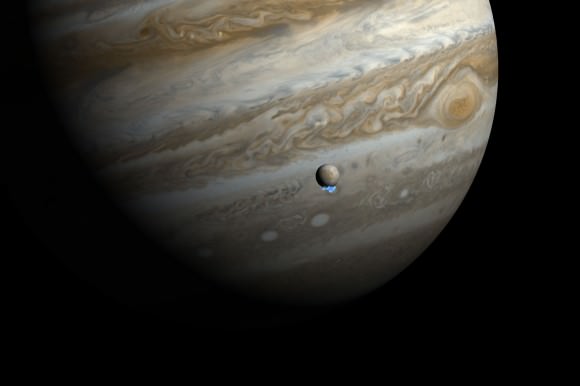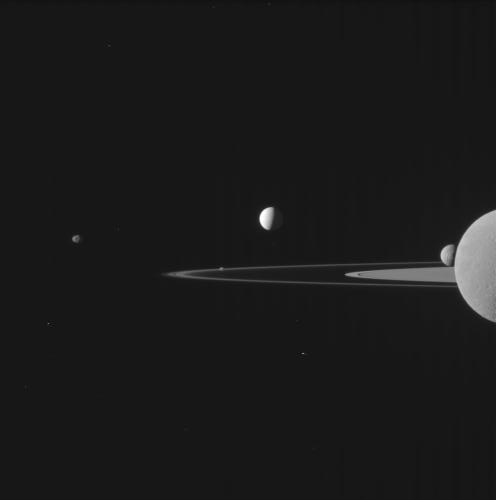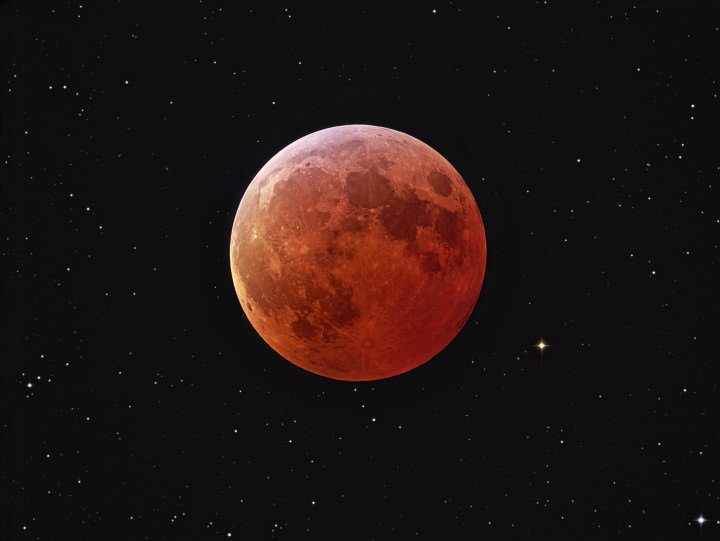What makes a planet a planet? The Moon is so big compared to the Earth — roughly one-quarter our planet’s size — that occasionally you will hear our system being referred to as a “double planet”. Is this correct?
And we all remember how quickly the definition of a planet changed in 2006 when more worlds similar to Pluto were discovered. So can the Moon stay the Moon, or is the definition subject to change?
Defining a planet
First, it’s important to understand what the official definition of a “planet” is, at least according to the International Astronomical Union. In its own words, according to a vote in Prague in 2006, the union has this definition:
“A planet is a celestial body that (a) is in orbit around the Sun, (b) has sufficient mass for its self-gravity to overcome rigid body forces so that it assumes a hydrostatic equilibrium (nearly round) shape, and (c) has cleared the neighborhood around its orbit.”
What this means is that a planet must move around the Sun (and not move around something else), that it’s massive enough to have a round shape due to gravity, and that it will swoop up any dust or debris in its orbit as it moves around the Sun.
But let’s be clear on something; the IAU definition of planet is not without controversy. There is still a strong contingent of people who say that Pluto is indeed a planet, including the principal investigator of a spacecraft (New Horizons) to examine the world: Alan Stern.
“It’s an awful definition; it’s sloppy science and it would never pass peer review,” he told the BBC in 2006. He said that the line between dwarf planets and planets is too artificial, and that the definition of a “cleared neighborhood” is muddy. The Earth alone has many asteroids that follow it — or approach or cross its orbit — not to mention the massive planet Jupiter.

Definition of a ‘satellite’
The Moon is not a unique phenomenon in our Solar System, in the sense that there are other planets that have satellites around them. Jupiter and Saturn have many dozens! Referring again to the IAU, the union also said in 2006 that it does not consider Charon a dwarf planet despite its large relative size to Pluto.
But Charon’s status as a moon could change in future, the IAU acknowledged. That’s primarily because the center of gravity in the system is not inside of Pluto, but in “free space between Pluto and Charon”. This center is called the “barycenter”, technically — and in Jupiter and Saturn’s cases, for example, all the barycenters of the various moons reside “inside” the huge gas giants.
Another caution, however: the IAU says “there has been no official recognition that the location of the barycenter is involved with the definition of a satellite.” So for now, it doesn’t have any bearing. That said, one question to consider is if the Moon’s barycenter is inside the Earth?

The answer right now is “yes”. But over time, that barycenter will move outside of Earth. That’s because the Moon is slowly receding from our planet at a rate of about 3.8 centimeters (1.5 inches) a year. It’ll take a long time, but eventually the center of our system’s mass will not be within our planet.
And if you read back to an IAU interview in 2006, you’ll see that at that time, the IAU defined a “double planet” as a system where both bodies meet the definition of a planet, and the barycenter is not inside either one of the objects. So for now, the Earth is a planet and the Moon a satellite — at least under IAU rules.
We have written many articles about the Moon for Universe Today. Here’s an article about how long it takes to get to the Moon, and here are some interesting facts about the Moon. We’ve also recorded an entire episode of Astronomy Cast all about the Moon. Listen here, Episode 113: The Moon, Part 1.


Culturally the planets have always been the seven objects which apparently orbit Earth: the Moon, the Sun, Mercury, Venus, Mars, Jupiter, Saturn. That’s why the week has seven days, each one named after one of the planets. It is part of the established calendar system. In this sense, the Moon is the only real planet, because it is the only one which actually orbits Earth. It describes epicycles around the Sun. It was only in the 17th century that it was discovered that Earth is a planet and that the Moon and the Sun have fundamentally different orbital characteristics than the (other) planets.
It is plain silly of the IAU to try to define what a planet is. How long is a string? According to their definition now, Mercury and Jupiter are of the same kind because they are so similar, that is a very helpful categorization, isn’t it!? And is Neptune a planet, has it cleared Pluto/Charon+moons? What are exoplanets and exodwarfplanets? Is a hot super-Jupiter which hasn’t “cleared its path”, really a “dwarf” planet? They shouldn’t have gotten themselves into this mess. People informally debating whether Sedna and Ceres are planets (planetoids, plutoids) would’ve been a much lesser headache, while officially sticking with the 9 which culturally are the planets today, without any unnecessary attempt of a stringent definition.
Now people use the term “world” when they refer to Titan, Ceres, Mars.
It’s pretty clear that if the Moon was orbiting the Sun, without the Earth around, it would be called a planet. Or if we found a Moon-sized object orbiting another star, it would be called a planet.
And if Mercury had orbited a planet, it would’ve been a Moon. The orbital characteristics is one way to categorize celestial objects. Terrestrial/gaseous is another. Atmospheric terrestrial or icy would be another. There is no one word which can meaningfully describe this. “Planet” means wanderer and refers to what moves on the sky as seen from Earth. The IAU has miraculously failed to understand this.
Yes, that’s true. Ganymede and Titan are bigger than Mercury but are not called planets.
Here’s an interesting hypothetical. Suppose Venus or Mars had a satellite as big as our Moon. This object would be visible to the naked eye, and would have been known since prehistory. Would our nomenclature for types Solar system objects be different?
It certainly would’ve made the understanding of orbital mechanics much easier if the moons of Jupiter had been visible by naked eye. Then the true nature of the Solar system would’ve been evident since ancient times. Now everything naively looks as if it orbits Earth. And the Moon actually does, while Earth orbits the Sun, as does the other planets. It was a really tough mess to sort out from naked eye Earth observations alone. Epicycles should not be underestimated as a pragmatic solution for its time. A bit like the relativity/quantum thingy today. It works fine to describe everything, but it doesn’t fit together. It is pragmatic, but is it true? Is it the epicycle of our time?
Kepler had to work hard with his math in order to derive elliptical orbits from Tycho Brahe’s carefully measured eccentricity of Mars. Kudos to Tycho Brahe and Johannes Kepler, the first astrophysicists, the observer and the theorist! (The two had a love/hate relationship already back then 🙂
If Ganymede were as close to the sun as Mercury, its water/ice would have sublimated away leaving a core that would be smaller than Mercury.
I don’t know how much mass Titan would loose under the same heat but i wouldn’t take much to become smaller than Mercury.
Now THAT’S a headline that should jolt Dr. Brown out of his bead. 😉
Yea, I know how to spell bed. 😐
So perhaps when the Earth-Moon barycenter has moved outside of the Earth, the Moon will be the planet formerly known as the Moon.
🙂 great!
I really enjoyed the article. Much better than most on the topic. And the IAU definition of a planet is horribly flawed and very inconsistently applied.
So far as to whether our Earth-Moon system is a double planet? Of course it is! You just do the math to figure out that the Sun’s pull on the Moon is stronger than is the Earth’s pull on the Moon. That means it is more accurate to say that the Moon orbits the Sun than it is to say that the Moon orbits the Earth. It’s more than a little odd to say that the Moon is a moon if it does not, in reality, orbit the Earth.
But the Moon has been historically designated a Moon so the IAU concocted a definition which would preserve that ancient understanding by cloaking it with a pseudoscientific definition even if it is a very arbitrary definition. If I were still alive when the barycenter was skimming near the surface of the Earth and entering and leaving the terra firma as it passed in and out of mountains and was losing and gaining its status as a Moon many times a day – I’d be having so much fun calling them hundreds of times a day asking if the Moon is a moon right now!
As it is I find the IAU silly. They define “moon” in such a way as to maintain the historical definition of the Moon as a “moon” and give one guy a huge amount of publicity by specifically trashing the historical definition of a “planet” in order to take Pluto out of the picture.
It is also a whole lot of fun to realize that when the IAU trashed the planet designation that only a small fraction of their attendees were even present – most had already left. I’m not sure how many were present when they passed their “moon” daffinition.
In any case, the Moon orbits the Sun. The Earth orbits the Sun. They do it together with a barycenter which is currently located within the Earth. The Earth-Moon system is a double planet.
Whether an object is a planet or a moon (a satellite, or “companion” of another body) seems to me to be primarily a linguistic subject – much more than an astronomical, scientific question to solve. I’d much more like to know which Milky Way star is going to go supernova next or some other interesting astronomical riddles’s solutions.
By the way, one of them, concerning the Earth and the Moon: I wonder how the day and night on the surface of the Earth are going to look like once the barycenter of the Earth-Moon system reaches the surface of the Earth and leaves the Earth. Currently, the Earth rotates uniformly around almost its own center, since the barycenter is near the center of the Earth. But, imagine Earth rotating around, say, Hawaii, once the barycenter reaches the surface (at Hawaii, for instance). I wonder what the consequences would be?
A major problem is that so many people start out with the assumption that the IAU definition is THE “official” one. There actually is nothing other than consensus that makes the IAU the determinant of what is official. The 2006 decision was made by only four percent of IAU members, most of whom are not planetary scientists but other types of astronomers. It was immediately opposed by an equal number of professional astronomers in a formal petition. On several occasions, the IAU was asked to reopen the planet definition discussion, and its leadership adamantly refused.
According to the geophysical planet definition, what makes a planet a planet is that it is a non-self-luminous celestial spheroidal body orbiting a star, free floating in space, or even orbiting another planet. In other words, what makes a planet a planet are its intrinsic characteristics. If an object is not a star and is large enough for its gravity to squeeze it into a round or nearly round shape, it is a planet. By this definition, Earth’s moon qualifies as a planet. There is precedent for this, as even during the 19th century, some astronomers referred to moons large enough to be spherical as “secondary planets.” Stern has proposed calling them “satellite planets.”
Many of these spherical moons are top contenders for hosting microbial life and even for future human colonization.
Unlike the Earth and Moon, Pluto-Charon is a double planet system because the barycenter that both objects orbit is outside of Pluto.
I am so glad you said all this, Ms. Howell. This is my favorite article you have ever written, because you took a stand. Yes, someday, the Moon will be a binary dwarf planet, like Charon is to many planetary scientists (and little ole lay man me). I do think the Moon currently qualifies as a satellite planet as it has hydrostatic equilibrium. The IAU Executive Committee is a funny bunch. I emailed one of them once and he came off as very imperious, saying Pluto’s demotion was final. I found his pronouncement very presumptuous. After all, he is not an immortal, and will someday not be on the Executive Committee. And, of course, we will learn a lot more about Pluto from New Horizons — as long as NASA is planning on Charon the information.